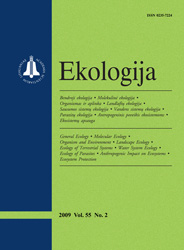 ISSN 0235-7224 ISSN 2029-0586 (online) |
2009 m. Nr. 1 Noise studies and reduction possibilities in a residential area located by a highway
Many residents suffer from traffic-generated noise. Traffic is the most prevailing source of noise in cities. With the number of vehicles increasing and traffic intensity growing, the awareness of environment pollution issues necessitates a search for noise reduction possibilities. Noise is justly considered as one of the key ecological problems in many cities and residential areas. Naujasodžiai residential area located by Highway A2 Vilnius–Panevėžys was selected for the investigation. The highest noise level in the daytime, 70–71 dBA, was recorded in the measurement locations A2–A3 at a 7.5 m distance from Highway A2 Vilnius–Panevėžys. Data of the spread of noise level indicates that higher levels of noise are recorded on the edges of the residential area. The measured level of traffic-generated noise in the residential area shows that the equivalent noise level limits are exceeded only within 30 m distance from the highway. This is mainly predetermined by the absence of noise reduction barriers. The spread of noise is partly subdued in the central part of the residential area by an embankment, running along the highway, planted with bushes and trees. The equivalent noise level measured at the height of 4.0 m in the living environment of Naujasodžiai residential area was around 1–2 dB bigger than at the height of 1.5 m. The most efficient way of reducing the noise is to install a noise-reduction wall on an embankment and to construct industrial-purpose buildings, i. e. shields, in the industrial zone in front of the residential area as well as to plant the slopes of the embankment. Keywords: traffic-generated noise, noise spread, noise level limit, noise reduction means |
Issues:
2011 - Vol.57 No. 1, No. 2 2010 - Vol.56 No. 1-2, No. 3-4 2009 - Vol.55 No. 1, No. 2, No. 3-4 2008 - Vol.54 No. 1, No. 2, No. 3, No. 4 2007 - Vol.53 No. 1, No. 2, No. 2.priedas, No. 3, No. 4 2006 No. 1, No. 2, No. 3, No. 4 2005 No. 1, No. 2, No. 3, No. 4 2004 No. 1, No. 2, No. 3, No. 4 2003 No. 1, No. 2, No. 3, No. 4 2002 No. 1, No. 2, No. 3, No. 4 2001 No. 1, No. 2, No. 3, No. 4 |